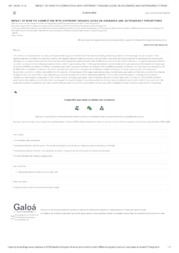Impact of wine ph correction with different organic acids on sourness and astringency perceptions.
Impact of wine ph correction with different organic acids on sourness and astringency perceptions.
Resumo: The control of pH is essential for red wines, as this parameter plays an important role in the chemical stability and sensory balance of the beverage. The pH values>3.7 favor oxidative reactions and affect the wine color stability. This research aimed to assess the impact of pH correction using lactic and tartaric acids on the perceptions of sourness and astringency in Touriga Nacional red wine. The wines were winemaking with grapes harvested with 22.8°Brix and pH value of 3.92. A total of 40meq L-1 of organic acids were added for correction to achieve a total acidity (expressed as tartaric acid) of approximately 6.5gL-1. Following international recommendations for reduced wine pH, the tested treatments were as follows: AT100%must=addition of 40meqL-1 of tartaric acid to the must before alcoholic fermentation (AF); AL100%must=addition of 40meqL-1 of lactic acid to the must before AF; AT50%AL50%must=addition of 20meqL-1 of tartaric acid and lactic acid to the must before AF; AL100%wine=addition of 40meqL-1 of lactic acid to the wine after malolactic fermentation; and Control=without acid addition for pH correction. A trained panel of 10 judges evaluated sourness and astringency perceptions of the wines using the time-intensity analysis and an unstructured 10cm scale. Regarding sourness, the samples did not differ significantly(p?0.05) in terms of the perceived maximum intensity, time to maximum intensity, and total duration of perception in the mouth. However, astringency perception was influenced by the pH correction treatments. The wine from the AL100% treatment, which involved the addition of lactic acid to the must, showed the lowest intensity of the attribute, while the other samples, including the control, did not differ from each other. This study demonstrates the potential use of lactic acid for reducing wine must pH as an alternative to tartaric acid, which is globally the most commonly used input for this purpose.
Ano de publicação: 2023
Tipo de publicação: Resumo em anais e proceedings
Unidade: Embrapa Meio Ambiente
Observações
1 - Por padrão são exibidas publicações dos últimos 20 anos. Para encontrar publicações mais antigas, configure o filtro ano de publicação, colocando o ano a partir do qual você deseja encontrar publicações. O filtro está na coluna da esquerda na busca acima.
2 - Para ler algumas publicações da Embrapa (apenas as que estão em formato ePub), é necessário ter, no celular ou computador, um desses softwares gratuitos. Sistemas Android: Google Play Livros; IOS: iBooks; Windows e Linux: software Calibre.
Acesse outras publicações
Acesse a Base de Dados da Pesquisa Agropecuária (BDPA) para consultar o acervo completo das bibliotecas da Embrapa.

